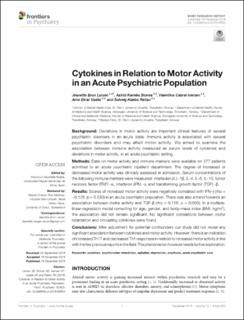| dc.contributor.author | Larsen, Jeanette Brun | |
| dc.contributor.author | Stunes, Astrid Kamilla | |
| dc.contributor.author | Iversen, Valentina Cabral | |
| dc.contributor.author | Vaaler, Arne | |
| dc.contributor.author | Reitan, Solveig Merete Klæbo | |
| dc.date.accessioned | 2021-04-26T12:08:34Z | |
| dc.date.available | 2021-04-26T12:08:34Z | |
| dc.date.created | 2020-01-17T15:38:24Z | |
| dc.date.issued | 2019 | |
| dc.identifier.citation | Frontiers in Psychiatry. 2019, 10 1-7. | en_US |
| dc.identifier.issn | 1664-0640 | |
| dc.identifier.uri | https://hdl.handle.net/11250/2739618 | |
| dc.description.abstract | Background: Deviations in motor activity are important clinical features of several psychiatric disorders in an acute state. Immune activity is associated with several psychiatric disorders and may affect motor activity. We aimed to examine the association between immune activity measured as serum levels of cytokines and deviations in motor activity, in an acute psychiatric setting.
Methods: Data on motor activity and immune markers were available on 277 patients admitted to an acute psychiatric inpatient department. The degree of increased or decreased motor activity was clinically assessed at admission. Serum concentrations of the following immune markers were measured: interleukin (IL) -1β, IL-4, IL-6, IL-10, tumor necrosis factor (TNF) -α, interferon (IFN) -γ, and transforming growth factor (TGF) -β.
Results: Scores of increased motor activity were negatively correlated with IFN-γ (rho = −0.128, p = 0.033) in an acute psychiatric population. There was also a trend towards an association between motor activity and TGF-β (rho = 0.118, p = 0.050). In a multiple-linear-regression model correcting for age, gender, and body-mass index (BMI, kg/m2), the association did not remain significant. No significant correlations between motor retardation and circulating cytokines were found.
Conclusions: After adjustment for potential confounders our study did not reveal any significant association between cytokines and motor activity. However, there is an indication of increased Th17 and decreased Th1 responses in relation to increased motor activity in line with the few previous reports in the field. The phenomenon however needs further exploration. | en_US |
| dc.language.iso | eng | en_US |
| dc.publisher | Frontiers | en_US |
| dc.rights | Navngivelse 4.0 Internasjonal | * |
| dc.rights.uri | http://creativecommons.org/licenses/by/4.0/deed.no | * |
| dc.title | Cytokines in Relation to Motor Activity in an Acute Psychiatric Population | en_US |
| dc.type | Peer reviewed | en_US |
| dc.type | Journal article | en_US |
| dc.description.version | publishedVersion | en_US |
| dc.source.pagenumber | 1-7 | en_US |
| dc.source.volume | 10 | en_US |
| dc.source.journal | Frontiers in Psychiatry | en_US |
| dc.identifier.doi | 10.3389/fpsyt.2019.00920 | |
| dc.identifier.cristin | 1776096 | |
| cristin.ispublished | true | |
| cristin.fulltext | original | |
| cristin.qualitycode | 1 | |

